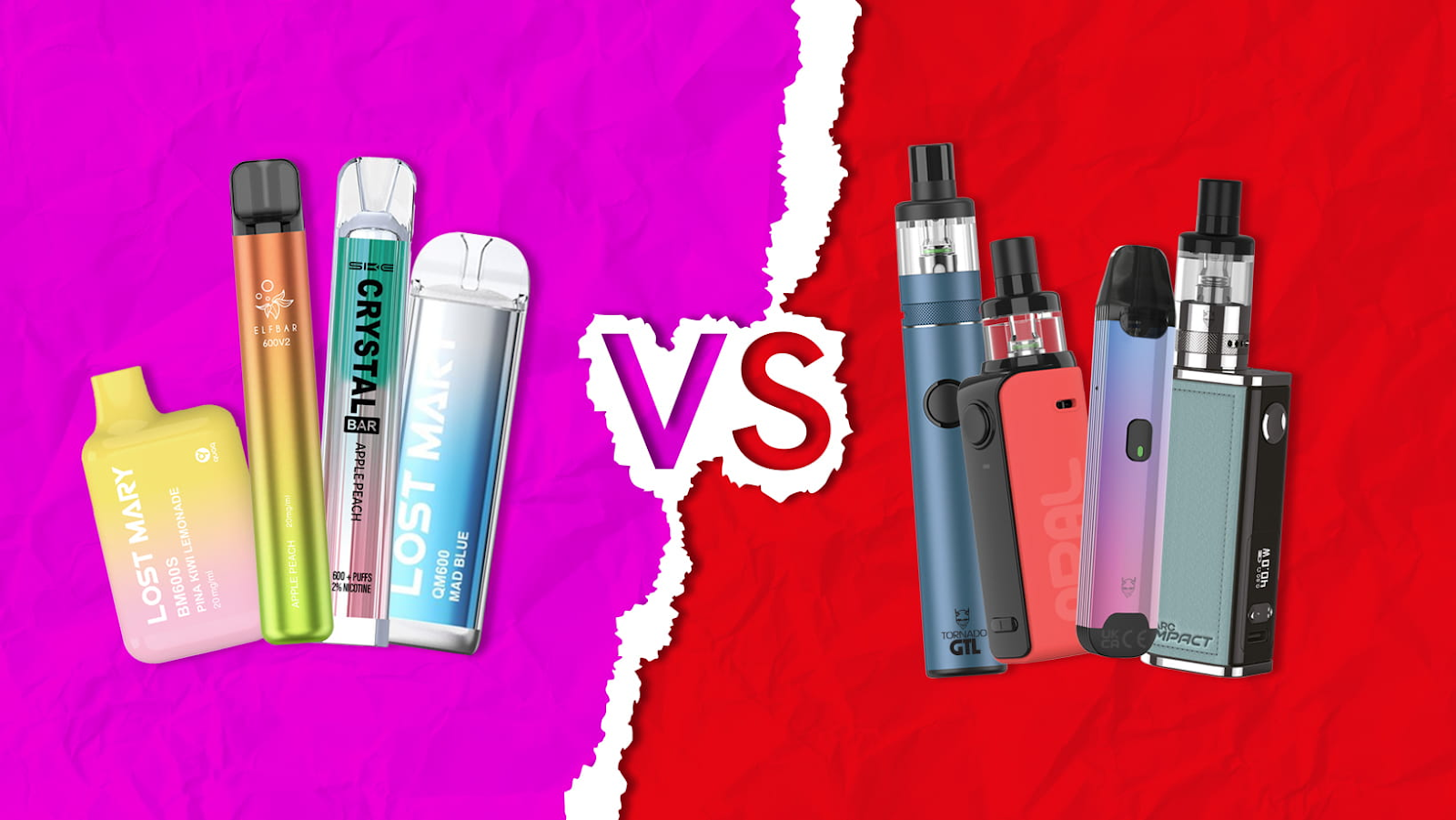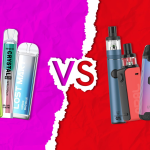
The vaping industry has exploded with variety in recent years. Today’s vapers can choose between disposable vapes, rechargeable vapes, pod systems, and advanced mods. While the convenience and portability of disposable vapes appeal to many users—especially beginners—health experts and seasoned vapers alike have started asking a critical question:
Are disposable vapes more harmful than rechargeable vapes?
In this article, we’ll break down the major differences between these two vape categories, compare health impacts, and provide insights to help you make a safer, more informed choice in your vaping journey.
Understanding the Basics: Disposable vs. Rechargeable Vapes
Before diving into health concerns, it’s essential to understand how disposable vapes and rechargeable vapes function.
🧊 Disposable Vapes
- Pre-filled with e-liquid
- Non-refillable and non-rechargeable
- Designed for single use (typically 300–5000 puffs)
- Tossed after the battery or e-liquid runs out
Popular brands: Geek Bar, Elf Bar, Lost Mary
🔋 Rechargeable Vapes
- Typically use refillable pods or tanks
- Rechargeable battery via USB or Type-C
- Allow customization of coils, flavors, and nicotine strength
- Longer lifespan and reusability
Popular types: JUUL-compatible pod systems, Vaporesso XROS, SMOK Nord
Health Considerations in Vaping
No vaping product is completely risk-free, especially when compared to not using nicotine at all. However, when evaluating the health impact of vaping, key factors include:
- Nicotine content and delivery
- Chemical exposure
- Battery safety
- Usage patterns
- Additives and flavorings
Now let’s explore how disposable and rechargeable vapes compare across these areas.
- Nicotine Delivery & Concentration
Many disposable vapes use nicotine salts, which deliver higher concentrations of nicotine with smoother throat hits. Some disposables contain up to 5% nicotine strength, which is equivalent to 50mg/mL—significantly higher than most traditional e-liquids.
⚠️ Why This Matters:
- High nicotine levels can lead to faster addiction, especially in younger or new users.
- Nicotine salts are absorbed into the bloodstream more quickly, increasing dependency risks.
Rechargeable vapes often allow users to customize nicotine levels, providing greater control over intake and helping with gradual reduction or cessation.
Verdict:
🔴 Disposable vapes may pose greater harm due to higher nicotine delivery.
- Chemical Exposure & E-Liquid Quality
E-liquids contain ingredients like propylene glycol, vegetable glycerin, flavorings, and nicotine. Some studies suggest that disposable vapes may contain additional chemicals due to mass production and lower quality control.
Common Issues in Disposables:
- Contaminants or unknown additives
- Overheating of coils leading to metal particle exposure
- Flavors with potentially toxic aldehydes when heated
In contrast, rechargeable vapes often use premium e-liquids, and users can select trusted vape juice brands with transparent ingredient lists.
Verdict:
🔴 Rechargeables typically offer safer and higher-quality vaping liquids.
- Battery Safety
Disposable vapes are not designed to be opened or recharged, meaning they use inexpensive, single-use lithium-ion batteries. If improperly stored or damaged, these batteries can:
- Leak or swell
- Overheat and cause burns
- Pose fire hazards if disposed of incorrectly
Rechargeable devices often come with regulated battery systems, built-in protection chips, and safe recharging protocols, reducing the risk of malfunction or injury.
Verdict:
🟠 Disposables pose a slightly higher battery safety risk due to their construction.
- Usage Patterns and Overuse Risk
Because disposable vapes are ultra-portable, flavorful, and high in nicotine, users often inhale more frequently and unconsciously. This can lead to:
- Nicotine overdose symptoms (dizziness, nausea, rapid heartbeat)
- Increased lung and throat irritation
- Greater potential for habitual use
Rechargeable vapes tend to require more involvement (charging, refilling), which naturally slows down use frequency, allowing more mindful consumption.
Verdict:
🔴 Disposable vapes often encourage overuse due to ease and high nicotine hit.
- Environmental & Long-Term Harm
One often overlooked consequence of disposable vapes is their environmental toll. Each unit includes plastic, lithium-ion batteries, and metal components—none of which are biodegradable.
Rechargeable vapes can last for months or even years with proper care, producing less e-waste and contributing to more sustainable vaping practices.
Verdict:
🟢 Rechargeables are significantly better for the environment and long-term health accountability.
Key Pros and Cons of Each
✅ Disposable Vapes
Pros:
- Convenient and portable
- No maintenance required
- Pre-filled with various flavor options
- Great for short-term or travel use
Cons:
- Higher nicotine concentrations
- Risk of overuse and faster addiction
- Poor battery safety design
- Environmental waste concerns
- Limited ingredient transparency
✅ Rechargeable Vapes
Pros:
- Lower, adjustable nicotine levels
- Higher-quality e-liquid options
- Cost-effective over time
- Safer batteries and regulated hardware
- Less environmental waste
Cons:
- Requires charging and refilling
- Slight learning curve for beginners
- More upfront investment
What the Science Says: Disposable vs. Rechargeable Health Impact
While long-term studies on vaping are still ongoing, preliminary findings from public health organizations suggest:
- Disposable vapes are more likely to be misused due to ease of access and high nicotine potency.
- Teens and young adults gravitate toward disposables, raising concerns about nicotine addiction.
- Rechargeable systems, particularly when paired with low-nicotine or nicotine-free vape juice, may pose lower health risks with mindful use.
A study published in Tobacco Control (2023) noted that disposable vape users reported more frequent puffing sessions than those using rechargeable devices, often unaware of how much nicotine they consumed.
Recommendations for Safer Vaping
If you’re currently vaping or considering starting, consider these harm-reduction strategies:
- ✅ Choose a rechargeable device with variable nicotine settings
- ✅ Use vape juice from reputable, lab-tested brands
- ✅ Avoid high-strength disposables, especially those over 5% nicotine
- ✅ Monitor your usage—be mindful of how often and how much you vape
- ✅ Dispose of devices properly to avoid environmental harm
Final Verdict: Are Disposable Vapes More Harmful?
Yes, in most cases. While disposable vapes are undeniably convenient, they typically carry higher nicotine levels, are easier to overuse, and come with less safety regulation compared to rechargeable vapes.
Rechargeable vapes, on the other hand, provide more control, flexibility, and safety—especially for long-term users or those looking to reduce harm or eventually quit.
If health, cost, and environmental impact matter to you, rechargeables are the better choice.
🔍 Bonus Tip:
For a reliable source of both disposable and rechargeable vapes, including top-tier vape juice and accessories, check out Empire Smoke Shop Glass & Vape or use a local vape delivery service for fast and safe access.







